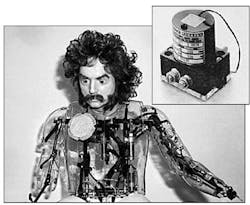Compact pneumatic servovalve meets animation challenges
Unusual performance specifications, space limitations, budget restraints. That list reads like a typical design assignment. But when motions must be lifelike when observed by a close-up human audience appears at the end of the list, you know you’ve found an animation job — that may need an artisan as well as a designer. This was the case when Sally Corp., Jacksonville, designed and built the Alderman character for display at the Tower Bridge Exhibit in London.
Smooth motion is imperative when building a good animated character. The human eye can detect any abrupt changes in acceleration or jerkiness in an animated character’s movements, thus spoiling the illusion. Simple onoff motions, such as eye blinking, can be accomplished digitally, but more complex movements, such as an elbow bending while twisting, need analog actuation to be lifelike. Depending upon the degree of performance desired, proportional or servo control may be needed.
Many animation motions tend to interact with or influence other motions. This can be illustrated by an arm curl move. The Alderman has to lift his forearm from the elbow joint through approximately 50° of arc, with the ability to accelerate and decelerate, extend or retract, stop, hold a position, make incremental moves to and from any point throughout the full range of motion, and do it all without overshooting, twitching, or jerking. Actually, this lifting motion is not all that difficult to control — until in the middle of the motion, an arm swing is required to rotate the forearm 90° into a horizontal plane. This changes an extremely biased force curve into an unbiased force curve. It is like the difference between the force needed to open the hood of a car (without counterbalancing springs) and the force required to open the car door! To complicate matters more, all these changes are reflected back into the character body through his shoulder joint, torso, legs, and on and on.
Dealing with such undesirable changes in mechanical gain is routine for animation designers. Looking at the arm-curl move in the drawing, the force curve is opposite of what is desirable. A full arm extension move needs much more force than is required for a bent arm move. By rotating the mechanism 908, the force curve becomes symmetrical with a much lower absolute value.
Absolute control is required to achieve smoothness over the wide range of motions required from animated characters. The work envelope within the character’s body is usually so limited that hydraulics often has been the attractive power option. However, hydraulics also presents a hazard to the animated character’s skin in the event of a rupture in the system or during maintenance. Advances in pneumatic servovalve technology have pushed air control to the forefront for animation artisans. For the Alderman character, Sally Corp. chose pneumatic actuation and control, using Model 125 Fun Valve servovalves from Schenck Pegasus, Troy, Mich.
Sally Corp. wanted valves that could be either sub-base or line mounted to match the space constrictions within the body of the Alderman. The Fun Valves provide this flexibility. In addition, while the forces required from actuators and mechanisms are light, little changes, caused by friction, geometry, etc., can have major effects. Therefore, highly responsive servo loops coupled with highly responsive servovalves are required. The control loop for each individual axis must be compensative to monitor and counteract the inertial displacements of unfavorable forces. Forgiveness in the positional accuracy — or smoothing at the end of a move — is just one of many techniques that are used to allow each actuator muscle to react gracefully so that the character’s movements do not appear robotic.
Pneumatics by its nature is spongy, but with other techniques such as using blocked-center servovalves, minimizing hose IDs, limiting line length where possible, thoughtful placement of actuators, and careful programming, unwanted and/or jerky character movements are eliminated. The servovalves used on the Alderman are single-stage, blocked-center, non-spool type, which dramatically increase system stiffness. This component meets the work envelope and budget requirements, and provides improvements in system stiffness and controllability. Visitors to the Tower Bridge Exhibit repeatedly comment on how truly lifelike the Alderman is and are amazed to learn that all the valving is housed within the small torso of the character.
Yan Rodriguez, electrical engineering supervisor, Sally Corp., and Hugh Jamieson, division manager-servovalves, Schenck Pegasus, provided details on the Alderman design.
About the Author
Richard Schneider
Contributing Editor
Contributing Editor, has been affiliated with Hydraulics & Pneumatics for more than 30 years and served as chief editor from 1987 through 2000. He received a BSME from Cornell University and also completed additional courses at the Milwaukee School of Engineering. His diverse background in industry includes ten years with a fluid power distributor and a variety of other professional positions. He has also been active with the National Fluid Power Association and Fluid Power Society.

Leaders relevant to this article:


